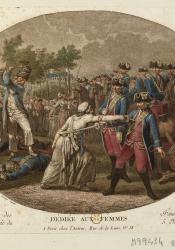Versailles/The Women's March on Versailles
What is the context of the women’s march on Versailles?
In May of 1789, the Estates-General (oxford dictionary defines this as the legislative body in France until 1789, representing the three estates of the realm (i.e., the clergy, the nobility, and the commons) was considering reforms, and then in July the Bastille was stormed. Then, in August, “Declaration of the Rights of Man and of the Citizen,” caused feudalism and some privileges of the nobility and royalty to be abolished.
It was clear at this point that disruption of regular order was happening in France. There was hope for change in government, but also fear, as radical action increased. Many nobles who were not French actually left France because they feared for their lives or money.
At this point, there had been poor harvests for years, and grain was very scarce. The price of bread increased rapidly, to the point that poorer citizens could not buy it. The market for sellers decreased as well, as less and less people could afford their product. This caused tensions to rise rapidly.
How did it start?
The women’s march on Versailles is one of the earliest significant parts of the French revolution. Bread was a staple in these people’s diets, yet they could no longer afford it. On October 5, 1789, one young woman began to beat a drum at the market in Paris. More women began to gather, and eventually they gathered a large crowd, marching through the streets. They reached the city hall in Paris, and had gathered about 6,000 – 10,000 women at this point. They were armed with simple weapons, like kitchen knives, and some even had muskets and swords. They gathered more weapons at the city hall, and any food they could find there.
Keeping the march calm-ish
Stanislas-Marie Maillard was a well-known leader among the market women, and he has been credited with calming the march as to make sure that marchers did not burn or destroy the city hall or any other buildings.
In the meantime, Marquis de Lafayette attempted to assemble guardsmen who sympathized or supported the marchers. Lafayette led 15,000 troops to Versailles to protect the marchers, and hoped this would keep the marchers from becoming an uncontrolled mob as well.
The march!
The objective of the marchers became to bring the king (Louis XVI) to Paris, so he could take responsibility for the people and the reforms. Essentially, they would march to the Palace of Versailles. The next morning, a smaller group invaded the palace, attempting to find the Queen. At least two guards were killed.
Lafayette eventually convinced the King to come out and address the people. He appeared, and as the people demanded to see the queen as well, she appeared.
The objective was fulfilled, as the group of marchers (about 60,000 now), accompanied the royal family back to Paris. The march ended on October 7.
Why is it important?
The women’s march on Versailles is particularly significant because it was a turning point in the revolution. Their successful storming of the palace proved that the monarchy is subject to the will of the people.
Works Cited
Hibbert, Christopher. “The Day of the Market-Women.” The Days of the French Revolution, Morrow Quill Paperbacks, New York, 1981, pp. 85–106.
Lewis, J. J. (2019, August 7). Women's March on Versailles: Turning point in the French Revolution. ThoughtCo. Retrieved April 25, 2022, from https://www.thoughtco.com/womens-march-on-versailles-3529107
Stephens, H. Morse. “Women During the Terror.” A History of the French Revolution, C. Scribner's Sons, New York, 1911, pp. 357–358.
Parent Map
Coordinates
Longitude: 2.120185300000

